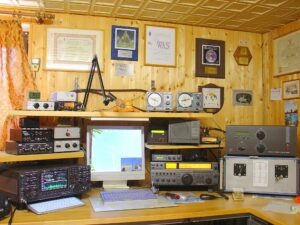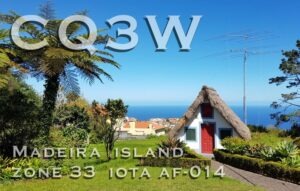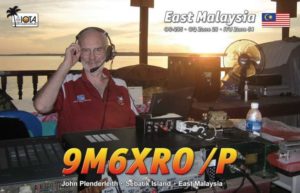Blíži sa CQ World Wide DX Contest, najväčšia rádioamatérska súťaž na svete. Posledný októbrový víkend (SSB) a november (CW) éter ožije viac ako 35 000 účastníkmi s cieľom nadviazať čo najväčší počet spojení s čo najväčším počtom rôznych entít DXCC a zón CQ.
Dosť sa diskutovalo o akceptácii účastníkov z Ruska a Bieloruska. Už pred časom padlo rozhodnutie, že:
1) S účinnosťou od CQ WW RTTY DX contestu 24. – 25. septembra 2022 a všetkých CQ contestov v budúcnosti budeme opäť prijímať ruské/bieloruské logy ako bežné logy, publikovať ich výsledky a započítavať QSO/body/násobiče vo všetkých súvisiacich logoch.
2) Plakety však nebudú udelené ruským/bieloruským staniciam. V prípade, že niektorá z týchto staníc má najlepšie skóre v danej kategórii, plaketa bude udelená najúspešnejšiemu neruskému/bieloruskému účastníkovi v danej kategórii.
3) Online certifikáty nebudú udelené žiadnej ruskej/bieloruskej stanici, a to ani ako cena pre účastníka, ani na základe umiestnenia.
4) CQ určí partnerov, s ktorými iniciuje humanitárny program na podporu obyvateľov Ukrajiny. Toto úsilie sa uskutoční buď v spolupráci so súčasnými aktivitami, alebo bude úplne nové. Podrobnosti o tomto programe budú oznámené priebežne.
5) Špecifiká rozhodnutia podliehajú budúcej revízii podľa toho, ako si to vyžiada vývoj.
Prameň: https://cqww.com/blog/updated-cq-contest-policy-relating-to-russias-invasion-of-ukraine/
CQWW Contest 2023

SSB
28. – 29. října
CW
25. – 26. listopadu
Začátek
00:00:00 UTC v sobotu Konec: 23:59:59 UTC v neděli
I. Cíl:
Pro amatéry na celém světě navázat co největší počet spojení v co největším počtu CQ zón a zemí.
II. PÁSMA
pouze šest pásem: 1,8, 3,5, 7, 14, 21 a 28 MHz. Dodržování stanovených frekvenčních plánů pásem je striktně požadováno.

III. SOUTĚŽNÍ KÓD
SSB: RS plus zóna CQ (například 59 05). CW: RST plus zóna CQ (např. 599 05).
IV. BODOVÁNÍ:
A. Výsledek: Konečný výsledek se vypočítá jako násobek celkového množství bodů za QSO krát součet zón a zemí. Příklad: 1000 bodů za QSO * (30 zón + 70 zemí) = 100 000 (konečné skóre).
B. Body za QSO: S každou stanicí lze navázat pouze jedno platné spojení na každém pásmu. Body za spojení jsou odvozeny podle polohy protistanice:
1. Za spojení mezi stanicemi na různých kontinentech se počítají tři (3) body.
2. Za spojení mezi stanicemi na stejném kontinentě, ale v různých zemích počítá jeden (1) bod. Výjimka: Za spojení mezi stanicemi v různých zemích na severoamerickém kontinentu se počítají dva (2) body.
3. Spojení mezi stanicemi ve stejné zemi mají nulovou (0) hodnotu, ale platí jako násobič zóny nebo země.
C. Násobiče: Jsou dva druhy násobičů:
1. Zóna: každá zóna CQ na každém pásmu zvlášť platí jako jeden násobič. Pro stanovení správné zóny platí pravidla CQ Worked All Zones.
2. Země: každá jednotlivá země na každém pásmu zvlášť platí jako jeden násobič. Jako jednotlivé země se počítají země DXCC, zvláštní země dle diplomu WAE plus IG9 / IH9. Stanice /MM se počítají pouze jako násobiče zón CQ.
V. SOUTĚŽNÍ KATEGORIE:

A. Kategorie jeden operátor (Single Operator): Jedna osoba (operátor) vykonává veškeré provozní činnosti včetně vedení deníku. Není žádné omezení pro provozní doby nebo změny pásma. V daném čase je povolen pouze jeden vysílaný signál.
1. Single Operator: pomoc jakéhokoli druhu je zakázána (viz VIII.2).
A. High Power (All band nebo Single band – všechna pásma nebo jedno pásmo): Celkový výstupní výkon nesmí překročit 1500 wattů.
B. Low Power (All band nebo Single band): Celkový výstupní výkon nesmí překročit 100 wattů.
C. QRP (All band nebo Single band): Celkový výstupní výkon nesmí překročit 5 wattů.
2. Single Operator Assisted: Soutěžící v této kategorii mohou používat pomoc (viz VIII.2).
A. High Power Assisted (All band nebo Single band): Celkový výstupní výkon nesmí překročit 1500 wattů.
B. Low Power Assisted (All band nebo Single band): Celkový výstupní výkon nesmí překročit 100 wattů.
C. QRP Assisted (All band nebo Single band): Celkový výstupní výkon nesmí překročit 5 wattů.
B. Single Operator kategorie Overlay: Jakýkoli účastník hlavní kategorie jeden operátor, který splňuje dané požadavky, se může zúčastnit také jedné z kategorií uvedených níže přidáním příslušné kategorie (OVERLAY) v záhlaví souboru deníku Cabrillo. Výsledky kategorií OVERLAY budou ve výsledkové listině uvedeny samostatně – v kategorii všechna pásma a rozděleny dle výkonu (včetně QRP).
1. Classic Operator (Overlay CLASSIC): Soutěžící smí používat pouze jedno rádio, bez pomoci, a může pracovat až 24 z celkového počtu 48 hodin
– přestávky musí být minimálně 60 minut, během kterých nebylo navázáno žádné spojení. Pokud deník obsahuje více než 24 hodin provozu, započítává se pro kategorii OVERLAY pouze výsledek prvních 24 hodin. Příjem při současném vysílání je zakázán. Kategorie s jedním operátorema assisted není pro tuto kategorii dovolena.
2. Rookie (Overlay ROOKIE): Operátoru byla jako radioamatérovi vydána licence ne dříve než tři (3) roky před datem soutěže. Uveďte datum vydání první licence v řádku SOAPBOX. Dřívější vítězové této kategorie již nemohou znovu získat plaketu pro vítěze.
3. Youth (YOUTH): Stáří operátora je maximálně 25 let, v kolonce SOAPBOX je třeba uvést rok narození.
C. Multi-Operator – více operátorů – (pouze all-band provoz): Je povolen libovolný počet operátorů. Pomoc (ASSISTED) při navazování spojení je povolena. Na jednom pásmu je možno použít současně jen jeden vysílací signál.
1. Jeden vysílač (MULTI-SINGLE): je povolen pouze jeden vysílaný signál na jednom pásmu v každém 10-minutovém intervalu – 10-minutové pravidlo – (hlavní (run) stanice / signál). Výjimka: jeden – a pouze jeden – druhý vysílaný signál (násobičová stanice / signál) může být použit při každém 10-minutovém intervalu, je-li – a pouze v případě, – že je na jiném pásmu od pásma hlavního vysílače (run) a navázané spojení je novým násobičem. Hlavní a násobičový vysílače se řídí nezávislými 10minutovými pravidly. Desetiminutové intervaly začínají prvním QSO v daném pásmu. V deníku se musí uvést u každého spojení, která stanice / signál (hlavní nebo násobičová) spojení navázala. Násobičová stanice / signálu nesmí navazovat spojení voláním CQ. Ujistěte se prosím, že jste si přečetli sekci FAQ na adrese <cqww.com/rules_faq.htm>.
A. High Power: Celkový výstupní výkon nesmí nikdy překročit 1500 W na libovolném pásmu.
B. Low Power: Celkový výstupní výkon nesmí nikdy překročit 100 wattů na libovolném pásmu.
2. Dva vysílače (MULTI-TWO): jsou povoleny maximálně dva vysílací signály na dvou různých pásmech (mohou být použity kdykoliv). V deníku musí být uvedeno u každého spojení, která stanice (1,2) spojení navázala. Každá stanice / signál může provést maximálně 8 změn pásma v jakékoliv jedné celé hodině začínají prvním QSO v daném pásmu. V deníku se musí uvést u každého spojení, která stanice / signál (hlavní nebo násobičová) spojení navázala. Násobičová stanice / signálu nesmí navazovat spojení voláním CQ. Ujistěte se prosím, že jste si přečetli sekci FAQ na adrese <cqww.com/rules_faq.htm>. (00 až 59 minut). Celkový výstupní výkon nesmí v žádném okamžiku překročit 1500 W na žádném pásmu.
3. Více vysílačů (MULTI-MULTI): Šest soutěžních pásem může být aktivováno současně. Na každém pásmu je povolen současně pouze jeden vysílací signál. Celkový výstupní výkon nesmí v žádném okamžiku překročit 1500 W na žádném pásmu.
D. Explorer: Kategorie Explorer se zavádí pro umožnění účasti stanic s inovativní strategií, novými technologiemi a pod. Více viz <cqww.com/explorer.htm>.
E. checklog: Deník se zasílá pouze pro kontrolu. Stanice nebude uvedena ve výsledkové listině a její deník nebude zveřejněn.

VI. DIPLOMY:
Jednopásmový deník bude mít nárok pouze na diplom (plaketu) za jedno pásmo. Deník obsahující více než jedno pásmo bude považován za deník pro všechny pásma, pokud není označen jako deník pro kategorii jednoho pásma.
A. Diplomy: Elektronické diplomy budou k dispozici ke stažení pro každého, kdo pošle deník.
B. Plakety: Plakety se udělují za špičkový výkon v několika kategoriích. Aktuální seznam plaket a jejich sponzorů je na adrese <cqww.com/plaques.htm>. Jednotlivé stanici bude udělena pouze jedna plaketa. Stanice, která vyhrála plaketu, nebude zohledněna pro udělení ceny vítězi podoblasti; plaketa bude udělena druhému účastníkovi v této oblasti.
VII. Klubová soutěž:
Skóre klubu je celkové souhrnné skóre z deníků zaslaných jejími členy. Existují dvě samostatné kategorie soutěžních klubů.
A. USA Kluby: Účast je omezena na členy klubu, kteří mají bydliště v okruhu 250 mil od středu klubové oblasti.
B. DX Kluby: Účast je omezena na členy klubu, kteří mají bydliště v jedné z DXCC zemi, kde se klub nachází, nebo v rámci kruhu o poloměru 400 km od středu klubu.
C. Všeobecné pravidla klubu:
1. Národní organizace (např. JARL, REF nebo DARC) nejsou způsobilé pro klubovou soutěž.
2. Stanice s jedním operátorem lze počítat pouze k jednomu klubu. Skóre stanic s více operátory může být započítáno více klubům jako procento počtu členů klubu účastnících se provozu stanice. V deníku stanice musí být uveden celý název klubu (a přidělení klubů, pokud je multi-op).
3. Musí být přijaty nejméně čtyři deníky, aby byl klub uveden ve výsledcích. Checklog deníky se nepočítají pro klubové skóre.
4. Slovo „bydliště“ je definováno jako stálé, trvalé bydliště dané osoby pro právní účely.

VIII. DEFINICE POJMŮ:
1. Umístění stanice: Oblast, v níž jsou umístěny všechny vysílače, přijímače, zesilovače a antény. Všechny vysílače a přijímače musí být v jednom kruhu o průměru 500 metrů. Antény musí být fyzicky propojeny vysokofrekvenčními přenosovými linkami na vysílače a přijímače.
2. Pomoc při navazování QSO (Assisted): Použití jakékoliv technologie nebo jiného zdroje, který poskytuje volací znak nebo identifikaci násobiče přijímaného signálu operátoru. To zahrnuje mimo jiné použití dekodéru CW, DX clusteru, webových stránek DX (např. DX summit), lokálních nebo vzdálených technologií dekódování volacích značek a frekvencí (např. CW skimmer nebo Reverse Beacon
Network) nebo pomoc týkajících se jiných osob.

IX. OBECNÁ PRAVIDLA PRO VŠECHNY DENÍKY:
1. Účastníci soutěže musí pracovat v mezích své zvolené kategorie při provádění jakékoliv činnosti, která by mohla mít vliv na jejich předložené skóre.
2. Pro každý deník musí být použita různá volací značka. Pro hodnocení výsledku účastníka lze použít pouze volací značku účastníka.
3. Nepřekračujte omezení celkového výstupního výkonu zvolené kategorie v libovolném pásmu. Celkový výstupní výkon v kterémkoli pásmu se měří na výstupu aktivního zesilovače.
4. Zadávání vlastní značky (self-spotting) nebo požadování o zadání značky do clusteru je zakázáno.
5. Použití vzdáleného ovládání je povoleno, pokud je fyzické umístění všech vysílačů, přijímačů a antén je na jednom místě. Dálkově ovládaná stanice musí dodržovat všechna omezení stanice, licence operátora a kategorie. Použitý volací znak musí být vydán nebo povolen regulačním orgánem podle umístění stanice.
6. Vzdálené přijímače mimo stanici nejsou povoleny.
7. Je povolen pouze jeden signál na jednom pásmu současně. Pokud jsou na stejném pásmu použity dva nebo více vysílačů, musí být použito takové hardwarové zařízení, aby se zabránilo více než jednomu signálu současně ve stejnou dobu. Střídání CQ na dvou nebo více frekvencích v pásmu není povoleno.
8. Veškeré žádosti na spojení, odpovědi na volání a záznam volacích značek a výměny soutěžních kódů musí být provedeny během trvání soutěže pomocí režimu a frekvencí soutěže (zvolené soutěžní kategorie).
9. Oprava zaznamenaných volacích značek a výměn po soutěži pomocí jakékoli databáze, nahrávek, e-mailů nebo jiných metod není povolená.
10. Zaznamenané volací značky musí být stejné, jako ty, které vyměňovaly účastníci během QSO.
11. Pro stanice regionu ITU 1: pro 40m pásmo vysílací frekvence nad 7200 kHz při SSB závodě nejsou povoleny.
12. Pro stanice region ITU 1: vysílat pod 1810 kHz během závodu není povoleno.

X. INSTRUKCE PRO POSÍLÁNÍ DENÍKU:
Je vyžadováno elektronické zaslání deníku je pro všechny účastníky závodu, kteří používají k záznamu deníku nebo jeho přípravě počítač.
1. Deník musí obsahovat pro každé spojení následující údaje: správné datum a čas v UTC, použitou frekvenci (nebo pásmo), volací znak stanice se kterou bylo spojení navázáno, poslaný soutěžní kód a přijatý soutěžní kód. Deník, který nebude obsahovat požadované údaje, bude brán pouze pro kontrolu – CHECKLOG. Spojení by měly být do deníku zaznamenány v okamžiku, kdy jsou dokončeny. Stanice, které soutěží o udělení světového a kontinentálního ocenění, musí do deníku udávat pro každé spojení i skutečnou frekvenci.
2. Stanice, které soutěží v kategorii jednoho pásma jsou povinni zahrnout do deníku i všechna spojení navázané v soutěžním době i na jiných pásmech (tedy kompletní deník ze všech pásem). Hodnoceny budou jen spojení navázaná na pásmu specifikovaném v záhlaví Cabrillo nebo souhrnu. Deníky se spojeními pouze na jednom pásmu budou hodnoceny v kategorii jedno pásmo.
3. Standardním formátem deníku je soubor CABRILLO. Podrobné pokyny týkající se vyplnění záhlaví souboru CABRILLO najdete na stránkách <cqww.com/cabrillo.htm>. Pokud nebude správně uvedena soutěžní kategorii v záhlaví Cabrillo, může dojít k hodnocení v nesprávné kategorii nebo deník brán jen pro kontrolu – Checklog. Poznámka: stanice z USA musí uvést umístění stanice v
záhlaví CABRILLO (např. LOCALITY: OH).
4. Jediný způsob zaslání deníku je nahrání deníku na webu (WEB upload) . Webové nahrání deníku je k dispozici na adrese < cqww.com/logcheck/ >.
5. Instrukce pro elektronické deníky v jiném formátu než Cabrillo: Pokud nejste schopni poslat deník ve formátu Cabrillo, obraťte se na ředitele soutěže o pomoc s poskytnutím jiného formátu.
6. Potvrzení přijetí deníku: Příjem deníku bude potvrzeno e-mailem. Seznam přijatých deníku lze nalézt na <cqww.com>.
7. Stažení deníku z hodnocení: Soutěžící může stáhnout deník z hodnocení z jakéhokoliv důvodu do 30 dnů od uplynutí lhůty k odeslání deníku. Pro další instrukce kontaktujte ředitele soutěže.

XI. LOG DEADLINE – LHŮTA PRO ODESLÁNÍ DENÍKU:
1. Všechny deníky musí být zaslány do pěti (5) dnů po skončení soutěže: nejpozději do 2359 UTC dne 4.listopadu 2022 pro SSB část a 2359 UTC 2. prosince 2022 pro CW část závodu. Opětovné odeslání deníku po uplynutí lhůty způsobí, že deník bude považováno za pozdně odeslaný.
2. O prodloužení lhůty pro odeslání deníku lze požádat e-mailem na <cqww.com/contact/ > . V žádosti musí být uveden oprávněný důvod a musí být přijata před nejzazším termínem odeslání. Prodloužení termínu odeslání deníku se uděluje pouze po potvrzení ředitelem soutěže.
3. Deníky zaslané po termínu nebo poštovní razítko po termínu mohou být uvedeny ve výsledcích, ale nejsou způsobilé k udělení diplomů a plaket.

XII. ROZHODOVÁNÍ:
Soutěžní výbor CQ WW DX je zodpovědný za kontrolu a rozhodování o soutěžích. Od účastníků se očekává, že budou dodržovat pravidla a nejlepší radioamatérské způsoby. Porušení pravidel soutěže nebo nesportovní jednání může vést k disciplinárnímu jednání výboru.
A. Nesportovní chování: Příklady nesportovního chování zahrnují, ale nejsou omezeny jen na:
1. Domluva nebo potvrzování spojení v průběhu nebo po skončení soutěže pomocí jakéhokoli neamatérského rádiového prostředku, jako jsou telefony, internet, instant messaging, chatovací programy, VoIP, e-mail, sociální média nebo webové stránky.
2. Vysílání účastníka na frekvencích mimo frekvence dané licencí účastníka.
3. Změna času v deníku za účelem splnění pravidel pro změnu pásma nebo času přestávek.
4. Započítání nadměrného počtu neověřitelných spojení nebo násobičů.
5. Vysíláním signálem s nadměrnou šířkou pásma (např. splitry, kliksy) harmonické frekvence na jiných pásmech.
6. Hlavní stanice udělá více jak tři spojení bez vyslání vlastní značky.
B. Zvukové nahrávky: Každý jednotlivý účastník (viz VA1) usilující o umístění na prvních pěti místech na (a) světě, (b) kontinentu, nebo (c) kategoriích USA, včetně hodnocení v kategorii OVERLAY CLASSIC, je povinen zaznamenat vysílaný i přijímaný signál po celou dobu trvání provozu své stanice. Nahrávka musí být ve společném formátu (např. MP3) a měla by zahrnovat zvuk do každého ucha jako samostatný kanál. Nahrávání musí být v čase nepřetržité (ne nahrávání jednotlivých QSO). Doba „přestávky“ (pokud není vysílán nebo
přijímán signál) nemusí být zaznamenána. Nahrávka může být vyžádána soutěžním výborem do 120 dnů po uplynutí lhůty pro zaslání deníku. Nahrané soubory musí být poskytnuty účastníkem do 5 dnů od požadavku. Není-li žádný záznam k dispozici, může dojít k
r e k v a l i f i k a c i deníku jen pro kontrolu nebo diskvalifikaci.
C. Disciplinární opatření: V případě porušení podmínek závodu účastník podléhá diskvalifikaci podle uvážení výboru.
1. Diskvalifikované deníky budou uvedeny na konci zveřejněných výsledků a nejsou způsobilé pro udělení diplomů nebo plaket.
2. Oznámení o rozhodnutí výboru bude zasláno účastníku e-mailem na adresu poskytnutou při odesílání deníku. Soutěžící má pět dní na odvolání k řediteli soutěže. Po uplynutí této doby je rozhodnutí konečné.
3. Výbor si vyhrazuje právo změnit kategorii jakéhokoli deníku na základě přezkoumání deníku nebo jiných informací.
D. Kontrola deníku: Všechny deníky jsou kontrolovány pomocí speciálních programů a lidských úsudků.
1. Duplicitní spojení budou odstraněny bez dalších penalizací.
2. Spojení s nesprávně přijatým soutěžním kódemcí budou odstraněny bez dalších penalizací.
3. Chyby ve volací značce protistanice nebo chybějící spojení v deníku protistanice budou mít za následek odstranění daného spojení a penalizaci ve výši dvojnásobku hodnoty bodů pro dané spojení.

XIII. PROHLÁŠENÍ:
Odesláním deníku ze soutěže CQ WW DX a vzhledem k úsilí soutěžního výboru CQ WW DX k přezkoumání a vyhodnocení tohoto deníku účastník bezpodmínečně a neodvolatelněsouhlasí, že: 1) přečetl a porozuměl pravidlům soutěže a souhlasí s tím, že je bude dodržovat, 2) bude provozovat stanici podle všech pravidel a předpisů, které se týkají amatérského vysílání v dané zemi umístění stanice, 3) souhlasí s tím, že obsah deníku může být zpřístupněn veřejnosti a 4) diskvalifikace a další rozhodnutí výboru jsou oficiální a
konečné. Nesouhlasí-li účastník se všemi výše uvedenými skutečnostmi, pak by neměl posílat deník ze závodu nebo má odeslat deník pouze pro kontrolu.
Otázky týkající se pravidel závodu CQ WW DX lze zasílat e-mailem na < cqww.com/contact/> . Odpovědi na nejčastější dotazy najdete na < cqww.com/rules_faq.htm >.
Prameň: https://cqww.com/rules.htm
